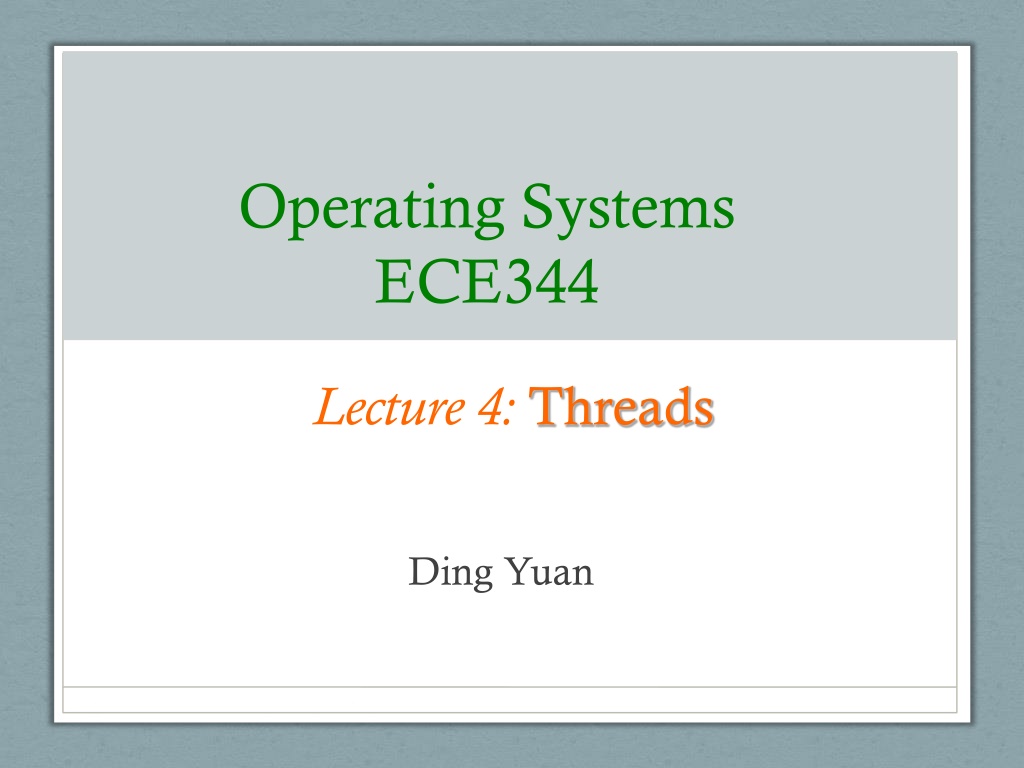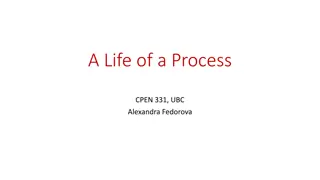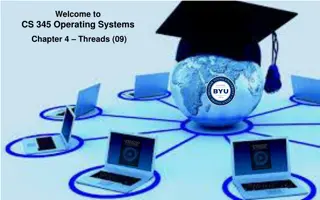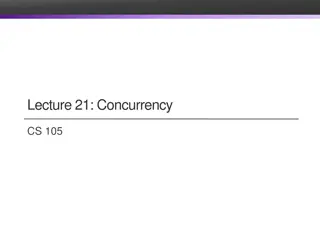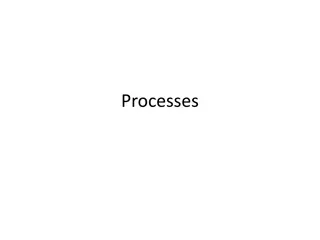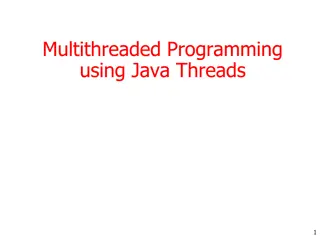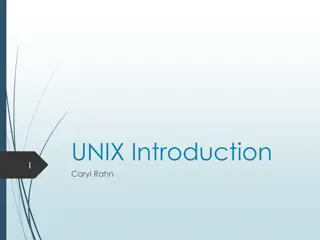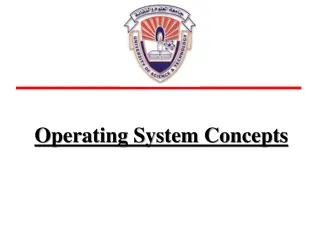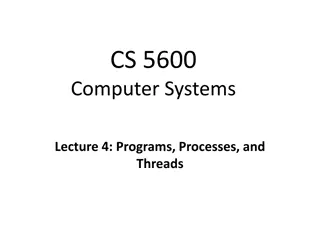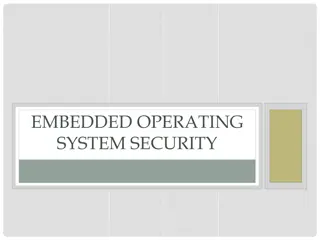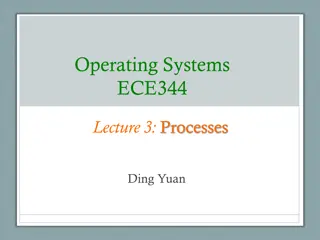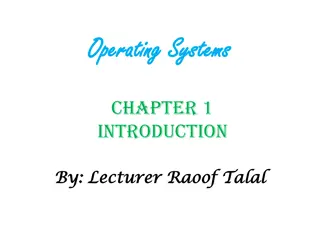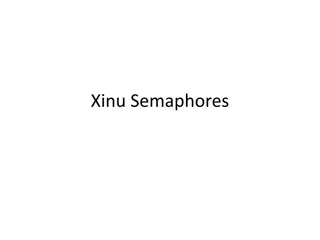Rethinking Processes with Threads in Operating Systems
Processes in operating systems traditionally include various resources and execution states, leading to inefficiencies in communication and parallel program execution. By separating the concept of a process from its execution state, modern OSes like Mac, Windows, and Unix introduce threads as lightweight processes within a single process, enabling more efficient resource sharing and scheduling.
Download Presentation

Please find below an Image/Link to download the presentation.
The content on the website is provided AS IS for your information and personal use only. It may not be sold, licensed, or shared on other websites without obtaining consent from the author.If you encounter any issues during the download, it is possible that the publisher has removed the file from their server.
You are allowed to download the files provided on this website for personal or commercial use, subject to the condition that they are used lawfully. All files are the property of their respective owners.
The content on the website is provided AS IS for your information and personal use only. It may not be sold, licensed, or shared on other websites without obtaining consent from the author.
E N D
Presentation Transcript
Operating Systems ECE344 Lecture 4: Threads Ding Yuan
Processes Recall that a process includes many things An address space (defining all the code and data pages) OS resources (e.g., open files) and accounting information Execution state (PC, SP, regs, etc.) Creating a new process is costly because of all of the data structures that must be allocated and initialized Recall struct proc in Solaris which does not even include page tables, perhaps TLB flushing, etc. Communicating between processes is costly because most communication goes through the OS Overhead of system calls and copying data 10/5/2024 2 Ding Yuan, ECE344 Operating System
Parallel Programs To execute these programs we need to Create several processes that execute in parallel Cause each to map to the same address space to share data They are all part of the same computation Have the OS schedule these processes in parallel This situation is very inefficient Space: PCB, page tables, etc. Time: create data structures, fork and copy addr space, etc. Solutions: possible to have more efficient, yet cooperative processes ? 10/5/2024 3 Ding Yuan, ECE344 Operating System
Rethinking Processes What is similar in these cooperating processes? They all share the same code and data (address space) They all share the same privileges They all share the same resources (files, sockets, etc.) What don t they share? Each has its own execution state: PC, SP, and registers Key idea: Why don t we separate the concept of a process from its execution state? Process: address space, privileges, resources, etc. Execution state: PC, SP, registers Exec state also called thread of control, or thread 10/5/2024 4 Ding Yuan, ECE344 Operating System
Threads Modern OSes (Mac, Windows, modern Unix) separate the concepts of processes and threads The thread defines a sequential execution stream within a process (PC, SP, registers) The process defines the address space and general process attributes (everything but threads of execution) A thread is bound to a single process Processes, however, can have multiple threads Threads become the unit of scheduling Processes are now the containers in which threads execute 10/5/2024 5 Ding Yuan, ECE344 Operating System
Threads: lightweight processes execution environment (resource) (a) Three processes each with one thread (b) One process with three threads 6 Ding Yuan, ECE344 Operating System 10/5/2024
The thread model Shared information Processor info: parent process, time, etc Memory: segments, page table, and stats, etc I/O and file: communication ports, directories and file descriptors, etc Private state State (ready, running and blocked) Registers Program counter Execution stack Why? Each thread execute separately 7 Ding Yuan, ECE344 Operating System 10/5/2024
Threads in a Process Stack (T1) Thread 1 Thread 2 Stack (T2) Stack (T3) Thread 3 Heap Static Data PC (T3) PC (T2) Code PC (T1) 10/5/2024 8 Ding Yuan, ECE344 Operating System
Threads: Concurrent Servers Using fork() to create new processes to handle requests in parallel is overkill for such a simple task Recall our forking Web server: while (1) { int sock = accept(); if ((child_pid = fork()) == 0) { Handle client request Close socket and exit } else { Close socket } } 10/5/2024 9 Ding Yuan, ECE344 Operating System
Threads: Concurrent Servers Instead, we can create a new thread for each request web_server() { while (1) { int sock = accept(); thread_create(handle_request, sock); } } handle_request(int sock) { Process request close(sock); } 10/5/2024 10 Ding Yuan, ECE344 Operating System
Thread usage: web server 11 Ding Yuan, ECE344 Operating System 10/5/2024
Thread usage: word processor A thread can wait for I/O, while the other threads can still running. What if it is single-threaded? 12 Ding Yuan, ECE344 Operating System 10/5/2024
Kernel-Level Threads We have taken the execution aspect of a process and separated it out into threads To make concurrency cheaper As such, the OS now manages threads and processes All thread operations are implemented in the kernel The OS schedules all of the threads in the system OS-managed threads are called kernel-level threads or lightweight processes Windows: threads Solaris: lightweight processes (LWP) POSIX Threads (pthreads): PTHREAD_SCOPE_SYSTEM 10/5/2024 13 Ding Yuan, ECE344 Operating System
Kernel-level Thread Limitations Kernel-level threads make concurrency much cheaper than processes Much less state to allocate and initialize However, for fine-grained concurrency, kernel-level threads still suffer from too much overhead Thread operations still require system calls Ideally, want thread operations to be as fast as a procedure call For such fine-grained concurrency, need even cheaper threads 10/5/2024 14 Ding Yuan, ECE344 Operating System
User-Level Threads To make threads cheap and fast, they need to be implemented at user level Kernel-level threads are managed by the OS User-level threads are managed entirely by the run-time system (user-level library) User-level threads are small and fast A thread is simply represented by a PC, registers, stack, and small thread control block (TCB) Creating a new thread, switching between threads, and synchronizing threads are done via procedure call No kernel involvement User-level thread operations 100x faster than kernel threads pthreads: PTHREAD_SCOPE_PROCESS 10/5/2024 15 Ding Yuan, ECE344 Operating System
User-level Thread Limitations But, user-level threads are not a perfect solution As with everything else, they are a tradeoff User-level threads are invisible to the OS They are not well integrated with the OS As a result, the OS can make poor decisions Scheduling a process with idle threads Blocking a process whose thread initiated an I/O, even though the process has other threads that can execute Solving this requires communication between the kernel and the user-level thread manager 10/5/2024 16 Ding Yuan, ECE344 Operating System
Kernel- vs. User-level Threads Kernel-level threads Integrated with OS (informed scheduling) Slow to create, manipulate, synchronize User-level threads Fast to create, manipulate, synchronize Not integrated with OS (uninformed scheduling) Understanding the differences between kernel- and user-level threads is important For programming (correctness, performance) For test-taking 10/5/2024 17 Ding Yuan, ECE344 Operating System
Kernel- and User-level Threads Or use both kernel- and user-level threads Can associate a user-level thread with a kernel-level thread Or, multiplex user-level threads on top of kernel-level threads Golang today uses user-level threads Multiplex multiple Goroutines (user-level threads) on multiple kernel level threads 10/5/2024 18 Ding Yuan, ECE344 Operating System
Implementing Threads Implementing threads has a number of issues Interface Context switch Preemptive vs. Non-preemptive What do they mean? Scheduling Synchronization (next lecture) Focus on user-level threads Kernel-level threads are similar to original process management and implementation in the OS 10/5/2024 19 Ding Yuan, ECE344 Operating System
Sample Thread Interface thread_create(procedure_t, arg) Create a new thread of control Start executing procedure_t thread_yield() Voluntarily give up the processor thread_exit() Terminate the calling thread; also thread_destroy thread_join(target_thread) Suspend the execution of calling thread until target_thread terminates 10/5/2024 20 Ding Yuan, ECE344 Operating System
Thread Scheduling For user-level thread: scheduling occurs entirely in user-space The thread scheduler determines when a thread runs It uses queues to keep track of what threads are doing Just like the OS and processes But it is implemented at user-level in a library Run queue: Threads currently running (usually one) Ready queue: Threads ready to run Are there wait queues? 10/5/2024 21 Ding Yuan, ECE344 Operating System
Non-Preemptive Scheduling Threads voluntarily give up the CPU with thread_yield Ping Thread Pong Thread while (1) { while (1) { printf( ping\n ); printf( pong\n ); thread_yield(); thread_yield(); } } What is the output of running these two threads? 10/5/2024 22 Ding Yuan, ECE344 Operating System
thread_yield() Wait a second. How does thread_yield() work? The semantics of thread_yield are that it gives up the CPU to another thread In other words, it context switches to another thread So what does it mean for thread_yield to return? It means that another thread called thread_yield! Execution trace of ping/pong printf( ping\n ); thread_yield(); printf( pong\n ); thread_yield(); 10/5/2024 23 Ding Yuan, ECE344 Operating System
Implementing thread_yield() thread_yield() { thread_t old_thread = current_thread; current_thread = get_next_thread(); append_to_queue(ready_queue, old_thread); context_switch(old_thread, current_thread); return; } As old thread As new thread The magic step is invoking context_switch() Why do we need to call append_to_queue()? 10/5/2024 24 Ding Yuan, ECE344 Operating System
Thread Context Switch The context switch routine does all of the magic Saves context of the currently running thread (old_thread) Push all machine state onto its stack (except stack pointer) Restores context of the next thread Pop all machine state from the next thread s stack The next thread becomes the current thread Return to caller as new thread This is all done in assembly language See arch/mips/mips/switch.S in OS161 (kernel thread implementation) 10/5/2024 25 Ding Yuan, ECE344 Operating System
Wait a minute Non-preemptive threads have to voluntarily give up CPU Only voluntary calls to thread_yield(), or thread_exit() causes a context switch What if one thread never release the CPU (never calls thread_yield())? We need preemptive user-level thread scheduling 26 Ding Yuan, ECE344 Operating System 10/5/2024
Preemptive Scheduling Preemptive scheduling causes an involuntary context switch Need to regain control of processor asynchronously How? Use timer interrupt Timer interrupt handler forces current thread to call thread_yield How? 10/5/2024 27 Ding Yuan, ECE344 Operating System
Process vs. threads Multithreading is only an option for cooperative tasks Trust and sharing Process Strong isolation but poor performance Thread Good performance but share too much Example: web browsers Google Chrome: each tab has its own process 28 Ding Yuan, ECE344 Operating System 10/5/2024
Threads Summary The operating system as a large multithreaded program Each process executes as a thread within the OS Multithreading is also very useful for applications Efficient multithreading requires fast primitives Processes are too heavyweight Solution is to separate threads from processes Kernel-level threads much better, but still significant overhead User-level threads even better, but not well integrated with OS Now, how do we get our threads to correctly cooperate with each other? Synchronization 10/5/2024 29 Ding Yuan, ECE344 Operating System
